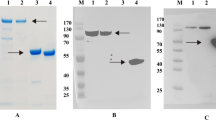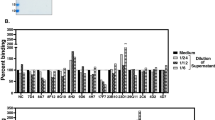Abstract
Tetanus as a life-threatening disease is characterized by muscle spasm. The disease is caused by the neurotoxin of Clostridium tetani. Active form of tetanus neurotoxin is composed of the light chain (fragment A) and the heavy chain. Fragment A is a zinc metalloprotease, which cleaves the neuronal soluble N-ethylmaleimide-sensitive attachment receptor (SNARE) protein, leading to the blockade of inhibitory neurotransmitter release and subsequent generalized muscular spasm. Two functional domains of the heavy chain are fragment C, which is required for neuronal cell binding of the toxin and subsequent endocytosis into the vesicles, and fragment B, which is important for fragment A translocation across the vesicular membrane into the neuronal cytosol. Currently, polyclonal immunoglobulins against tetanus neurotoxin obtained from human plasma of hyper-immunized donors are utilized for passive immunotherapy of tetanus; however, these preparations have many disadvantages including high lot-to-lot heterogeneity, possibility of transmitting microbial agents, and the adverse reactions to the other proteins in the plasma. Neutralizing anti-tetanus neurotoxin monoclonal antibodies (MAbs) lack these drawbacks and could be considered as a suitable alternative for passive immunotherapy of tetanus. In this review, we provide an overview of the literature discussing epitope mapping of the published neutralizing MAbs against tetanus toxin.


Similar content being viewed by others
References
Ahnert-higer G, Bizinni B, Goretzki K, Muller H, Volckers C, Habbermann E (1983) Monoclonal antibodies against tetanus toxin and toxoid. Med Microbiol Immunol 172:123–135
Arunachalam B, Ghosh S, Talwar GP, Raghupathy R (1992) A single human monoclonal antibody that confers total protection from tetanus. Hybridoma 11:165–179
Ashton AC, Li Y, Doussau F, Weller U, Dougan G, Poulain B, Dolly JO (1995) Tetanus toxin inhibits neuroexocytosis even when its Zn21-dependent protease activity is removed. J Biol Chem 270:31386–31390
Blum FC, Tepp WH, Johnson EA, Barbieri JT (2014) Multiple domains of tetanus toxin direct entry into primary neurons. Traffic 15:1057–1065
Chen C, Fu Z, Kim JJ, Barbieri JT, Baldwin MR (2009) Gangliosides as high affinity receptors for tetanus neurotoxin. J Biol Chem 284:26569–26577
Diamant E, Torgeman A, Ozeri E, Zichel R (2015) Monoclonal antibody combinations that present synergistic neutralizing activity: a platform for next-generation anti-toxin drugs. Toxins (Basel) 7:1854–1881
Council of Europe (2010) European pharmacopoeia. Council Of Europe : European Directorate for the Quality of Medicines and Healthcare, Strasbourg
Fairweather NF, Lyness VA, Maskell DJ (1987) Immunization of mice against tetanus with fragments of tetanus toxin synthesized in Escherichia coli. Infect Immul 55:2541–2545
Figueiredo D, Turcotte C, Frankel G, Li Y, Dolly O, Wilkin G, Marriott D, Fairweather N, Dougan G (1995) Characterization of recombinant tetanus toxin derivatives suitable for vaccine development. Infect Immun 63:3218–32121
Fitzsimmons SP, Clark KC, Wilkerson R, Shapiro MA (2000) Inhibition of tetanus toxin fragment C binding to ganglioside G(T1b) by monoclonal antibodies recognizing different epitopes. Vaccine 19:114–121
Gustafsson B, Whitmore E, Tiru M (1993) Neutralization of tetanus toxin by human monoclonal antibodies directed against tetanus toxin fragment C. Hybridoma 12:699–708
Helting TB, Zwisler O, Wiegandt H (1977) Structure of tetanus toxin. J Biol Chem 252:194–198
Kamei M, Hashizume S, Sugimoto N, Ozutsumi K, Matsuda M (1990) Establishment of stable mouse/human-human hybrid cell lines producing large amounts of anti-tetanus human monoclonal antibodies with high neutralizing activity. Eur J Epidemiol 6:386–397
Lalli G, Herreros J, Osborne SL, Montecucco C, Rossetto O, Schiavo G (1999) Functional characterisation of tetanus and botulinum neurotoxins binding domains. J Cell Sci 112:2715–27124
Lang AB, Cryz SJ Jr, Schurch U, Ganss MT, Bruderer U (1993) Immunotherapy with human monoclonal antibodies. Fragment A specificity of polyclonal and monoclonal antibodies is crucial for full protection against tetanus toxin. J Immunol 151:466–472
Lin CS, Habig WH, Hardegree MC (1985) Antibodies against the light chain of tetanus toxin in human sera. Infect Immul 49:111–115
Lukic I, Marinkovic E, Filipovic A, Krnjaja O, Kosanovic D, Inic-Kanada A, Stojanovic M (2015) Key protection factors against tetanus: anti-tetanus toxin antibody affinity and its ability to prevent tetanus toxin - ganglioside interaction. Toxicon 103:135–144
Luo P, Qin L, Mao X, Chen L, Yu S, Li Q, Liu W, Zhang W, Gu J, Zou Q (2012) Identification of a novel linear epitope in tetanus toxin recognized by a protective monoclonal antibody: implications for vaccine design. Vaccine 30:6449–6455
Matsuda M, Kamei M, Sugimoto N, Ma Y, Hashizume S (1992) Characteristics of toxin-neutralization by anti-tetanus human monoclonal antibodies directed against the three functional domains [A], [B] and [C] of the tetanus toxin molecule and a reliable method for evaluating the protective effects of monoclonal antibodies. Eur J Epidemiol 8:1–8
Pellizzari R, Rossetto O, Schiavo G, Montecucco C (1999) Tetanus and botulinum neurotoxins: mechanism of action and therapeutic uses. Philos Trans R Soc Lond Ser B Biol Sci 354:259–268
Petrusic V, Zivkovic I, Stojanovic M, Stojicevic I, Marinkovic E, Dimitrijevic L (2012) Production, characterization and applications of a tetanus toxin specific monoclonal antibody T-62. Acta Histochem 114:480–486
Pincus SH, Das A, Song K, Maresh GA, Corti M, Berry J (2014) Role of Fc in antibody-mediated protection from ricin toxin. Toxins (Basel) 6:1512–1525
Scott N, Qazi O, Wright MJ, Fairweather NF, Deonarain MP (2010) Characterisation of a panel of anti-tetanus toxin single-chain Fvs reveals cooperative binding. Mol Immunol 47:1931–1941
Scrivner D, Kristof S, Rodey G (1987) Human T4 + T-lymphocyte clones specific for the B fragment of tetanus toxin. Hum Immunol 19:245–254
Sheppard AJ, Cussell D, Hughes M (1984) Production and characterization of monoclonal antibodies to tetanus toxin. Infect Immun 43:710–714
Thwaites CL, Beeching NJ, Newton CR (2015) Maternal and neonatal tetanus. Lancet 385:362–370
Volk WA, Bizzini B, Snyder RM, Bernhard E, Wagner RR (1984) Neutralization of tetanus toxin by distinct monoclonal antibodies binding to multiple epitopes on the toxin molecule. Infect Immun 45:604–609
Yousefi M, Khosravi-Eghbal R, Reza Mahmoudi A, Jeddi-Tehrani M, Rabbani H, Shokri F (2014a) Comparative in vitro and in vivo assessment of toxin neutralization by anti-tetanus toxin monoclonal antibodies. Hum Vaccin Immunother 10:344–351
Yousefi M, Tahmasebi F, Younesi V, Razavi A, Khoshnoodi J, Bayat AA, Abbasi E, Rabbani H, Jeddi-tehrani M, Shokri F (2014b) Characterization of neutralizing monoclonal antibodies directed against tetanus toxin fragment C. J Immunotoxicol 11:28–34
Yousefi M, Younesi V, Bayat AA, Jadidi-Niaragh F, Abbasi E, Razavi A, Khosravi-eghbal R, Asgarian-omaran H, Shokri F (2016) Comparative human and mouse antibody responses against tetanus toxin at clonal level. J Immunotoxicol 13:243–248
Yu YZ, Gong ZW, Ma Y, Zhang SM, Zhu HQ, Wang WB, Du Y, Wang S, Yu WY, Sun ZW (2011) Co-expression of tetanus toxin fragment C in Escherichia coli with thioredoxin and its evaluation as an effective subunit vaccine candidate. Vaccine 29:5978–5985
Ziegler-Heitbrock HW, Reiter C, Trenkmann J, Futterer A, Riethmuller G (1986) Protection of mice against tetanus toxin by combination of two human monoclonal antibodies recognizing distinct epitopes on the toxin molecule. Hybridoma 5:21–31
Author information
Authors and Affiliations
Corresponding author
Ethics declarations
Conflict of Interest
The authors declare that they have no conflicts of interest.
Additional information
Publisher’s Note
Springer Nature remains neutral with regard to jurisdictional claims in published maps and institutional affiliations.
Rights and permissions
About this article
Cite this article
Ghotloo, S., Golsaz-Shirazi, F., Amiri, M.M. et al. Epitope Mapping of Tetanus Toxin by Monoclonal Antibodies: Implication for Immunotherapy and Vaccine Design. Neurotox Res 37, 239–249 (2020). https://doi.org/10.1007/s12640-019-00096-w
Received:
Revised:
Accepted:
Published:
Issue Date:
DOI: https://doi.org/10.1007/s12640-019-00096-w




